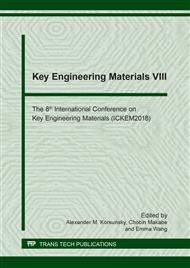[1]
Bregman, D. J. J., De Groot, V., Van Diggele, P., Meulman, H., Houdijk, H., & Harlaar, J. (2010).
Google Scholar
[2]
Chisholm, A. E., Perry, S. D. and McIlroy, W. E. Correlations between ankle foot impairments and dropped foot gait deviations among stroke survivors. Clinical Biomechanics, 2013. 28(9-10): 1049–1054. ISSN 02680033.
DOI: 10.1016/j.clinbiomech.2013.09.007
Google Scholar
[3]
Tanida, S., Kikuchi, T., Kakehashi, T., Otsuki, K., Ozawa, T., Fujikawa, T., Yasuda, T., Furusho, J., Morimoto, S. and Hashimoto, Y. Intelligently controllable Ankle Foot Orthosis (I-AFO) and its application for a patient of Guillain-Barre syndrome. 2009 IEEE International Conference on Rehabilitation Robotics, ICORR 2009, 2009: 857–862. ISSN 1945-7898.
DOI: 10.1109/icorr.2009.5209590
Google Scholar
[4]
Mahon, C. E. and Lewek, M. D. Individual limb mechanical analysis of gait following stroke. Journal of Biomechanics, 2013. 1538125(6): 43. ISSN 18732380.
Google Scholar
[5]
Delafontaine, A., Gagey, O., Colnaghi, S., Do, M.-C., & Honeine, J.-L. (2017). Rigid Ankle Foot Orthosis Deteriorates Mediolateral Balance Control and Vertical Braking during Gait Initiation. Frontiers in Human Neuroscience, 11(April), 1–10.
DOI: 10.3389/fnhum.2017.00214
Google Scholar
[6]
F. Frascarelli et al., The impact of robotic rehabilitation in children with acquired or congenital movement disorders,, Eur. J. Phys. Rehabil. Med., vol. 45, no. 1, p.41–135, Mar. (2009).
Google Scholar
[7]
Information on https://www.sparkfun.com/products/13723.
Google Scholar
[8]
Ferris, D. P., Gordon, K. E., Sawicki, G. S. and Peethambaran, A. An improved powered ankle-foot orthosis using proportional myoelectric control. Gait and Posture, 2006. 23(4): 425–428. ISSN 09666362.
DOI: 10.1016/j.gaitpost.2005.05.004
Google Scholar
[9]
Adiputra, D., Ubaidillah, Mazlan, S.A, Zamzuri, H., and Rahman, M.A.A. Fuzzy Logic Control for Ankle Foot Orthoses Equipped with Magnetorheological Brake. Jurnal Teknologi 78:11, 2016. 25-32.
DOI: 10.11113/.v78.7942
Google Scholar
[10]
Kikuchi, T., Tanida, S., Otsuki, K., Yasuda, T. and Furusho, J. Development of third-generation intelligently controllable ankle-foot orthosis with compact MR fluid brake. Proceedings - IEEE International Conference on Robotics and Automation, 2010: 2209–2214. ISSN 10504729.
DOI: 10.1109/robot.2010.5509729
Google Scholar
[11]
Kikuchi, T., Tanida, S., Otsuki, K., Yasuda, T. and Furusho, J. A novel estimating method of the gait state and velocity control in the initial stance phase for the intelligent ankle foot orthosis with compact MR fluid brake(iAFO). 2010. 10: 240–246.
DOI: 10.1109/robot.2010.5509729
Google Scholar
[12]
Fleischer, C. and Hommel, G. EMG-Driven Human Model for Orthosis Control. proceedings of the 6th annual Human Interaction with Machines workshop, 2006: 69–76.
DOI: 10.1007/1-4020-4043-1_8
Google Scholar
[13]
Young, a. J., Kuiken, T. a. and Hargrove, L. J. Analysis of using EMG and mechanical sensors to enhance intent recognition in powered lower limb prostheses. Journal of Neural Engineering, 2014. 11(5): 056021. ISSN 1741- 2560.
DOI: 10.1088/1741-2560/11/5/056021
Google Scholar
[14]
Nazmi, N., Shin-Ichiroh, Y., Rahman, M. A. A., Ahmad, S. A., Adiputra, D., Zamzuri, H., & Mazlan, S. A. (2016).
Google Scholar
[15]
Nazmi, N., Shin-Ichiroh, Y., Rahman, M. A. A., Ahmad, S. A., Adiputra, D., Zamzuri, H., & Mazlan, S. A. (2016).
Google Scholar
[16]
M. R. Jolly, J. D. Carlson, and B. C. Muñoz, A model of the behaviour of magnetorheological materials,, Smart Mater. Struct., vol. 5, no. 5, p.607–614, (1999).
DOI: 10.1088/0964-1726/5/5/009
Google Scholar
[17]
J. D. Carlson and M. R. Jolly, MR fluid, foam and elastomer devices,, Mechatronics, vol. 10, no. 4, p.555–569, (2000).
DOI: 10.1016/s0957-4158(99)00064-1
Google Scholar
[18]
X. Zhang, S. Peng, W. Wen, and W. Li, Analysis and fabrication of patterned magnetorheological elastomers,, Smart Mater. Struct., vol. 17, no. 4, p.45001, Aug. (2008).
DOI: 10.1088/0964-1726/17/4/045001
Google Scholar
[19]
I. Bica, Influence of the transverse magnetic field intensity upon the electric resistance of the magnetorheological elastomer containing graphite microparticles,, Mater. Lett., vol. 63, no. 26, p.2230–2232, (2009).
DOI: 10.1016/j.matlet.2009.07.032
Google Scholar
[20]
H. Zou, L. Zhang, M. Tian, S. Wu, and S. Zhao, Study on the structure and properties of conductive silicone rubber filled with nickel-coated graphite,, J. Appl. Polym. Sci., vol. 115, no. 5, p.2710–2717, Mar. (2009).
DOI: 10.1002/app.29901
Google Scholar
[21]
W. Li, K. Kostidis, X. Zhang, and Y. Zhou, Development of a Force Sensor Working with MR Elastomers,, p.233–238, (2009).
Google Scholar
[22]
G. Bossis, C. Abbo, S. Cutillas, S. Lacis, and C. Métayer, Electroactive and Electrostructured Elastomers,, Int. J. Mod. Phys. B, vol. 15, no. 06n07, p.564–573, (2001).
DOI: 10.1142/s0217979201005027
Google Scholar
[23]
T. F. Tian, W. H. Li, G. Alici, H. Du, and Y. M. Deng, Microstructure and magnetorheology of graphite-based MR elastomers,, Rheol. Acta, vol. 50, no. 9–10, p.825–836, (2011).
DOI: 10.1007/s00397-011-0567-9
Google Scholar
[24]
Bregman, D. J. J., De Groot, V., Van Diggele, P., Meulman, H., Houdijk, H., & Harlaar, J. (2010).
Google Scholar


